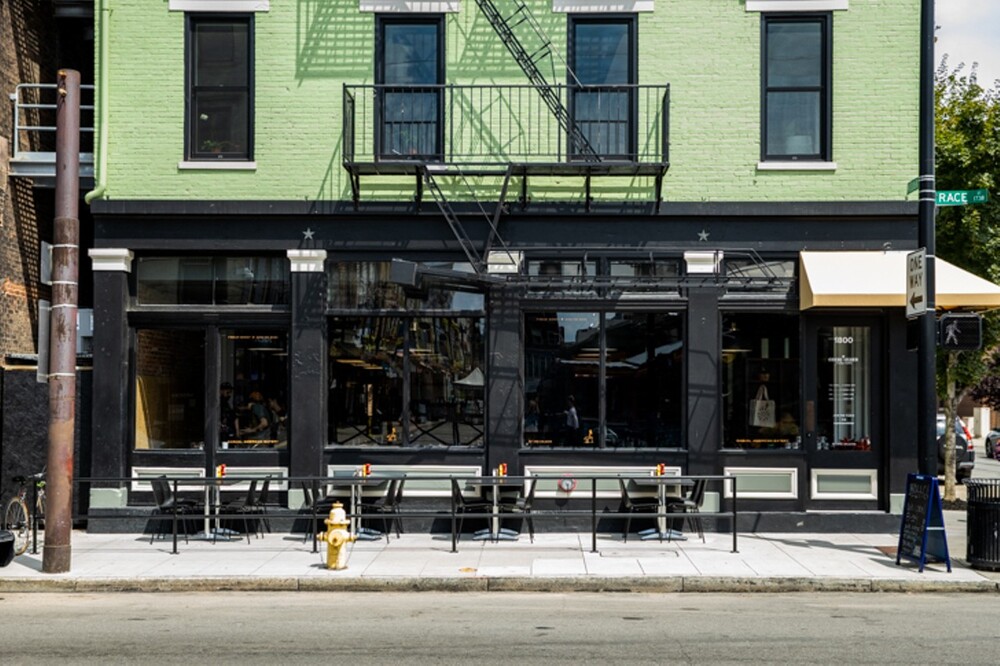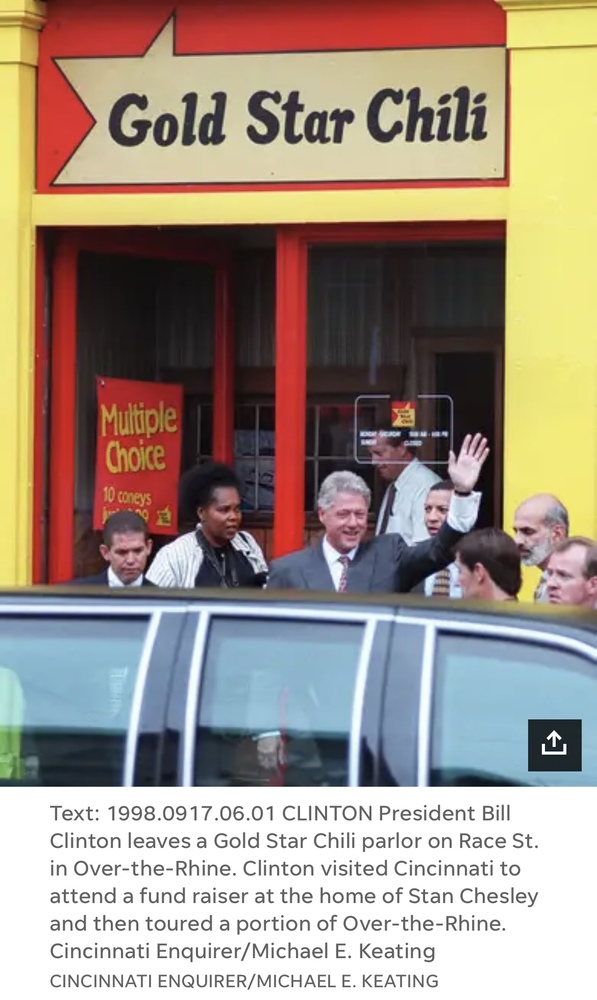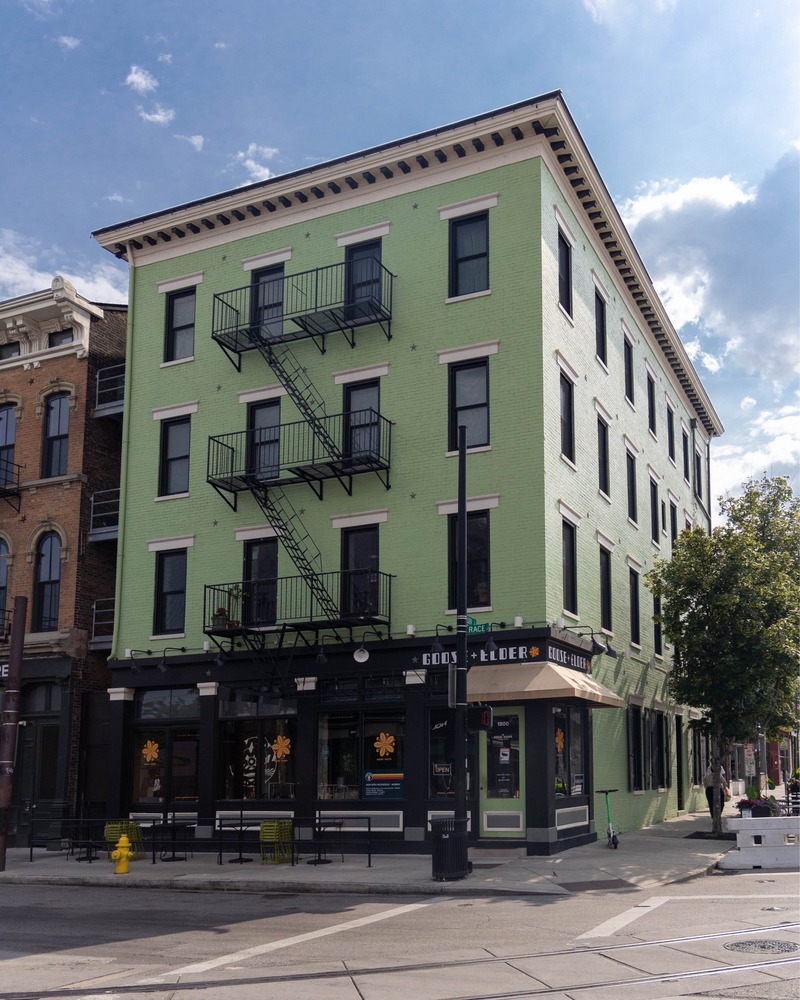
The 100-Year-Old Pharmacy at 1800 Race
City directories first listed the northeast corner of Race and Elder in 1857, with Michael Farhbach’s coffee house there. Michael was a German immigrant, born in 1822 in Baden. He lived here in Cincinnati with his wife Mary, also a German immigrant. He became a saloon proprietor by 1860 and passed away the following year.
In 1859, Adolph (or Adolphus) Stierle opened his apothecary business at the northeast corner of Race and Elder, initiating this spot as a pharmacy in its long history. The four-story brick structure at 1800 Race then housed Muhlberg’s Pharmacy, all the way up to the early 1960s. It was the longest-running business at Findlay Market and since it was originally established (at a non-Findlay Market location) in 1848, Muhlberg’s was considered one of—if not the—oldest pharmacy in Cincinnati.
William Muhlberg (sometimes listed as Muehlberg), a German immigrant and pharmacist, was the original founder of Muhlberg’s. Born in Eisenberg, Saxony, in 1823, William studied medicine and pharmacy at the University of Leipzig and then fled to the U.S. after participating in the failed 1848 Revolution. He lived briefly in New York City before migrating to Cincinnati.
In April of 1848, he set up his pharmacy with a business partner, Charles Fritsch, at the corner of Central Avenue and Armory Avenue in the West End. At that time, he purchased Adolph Stierle’s store at 1800 Race and moved his business there. (His sons contradicted this, saying that the business did not move to 1800 Race until 1872; they also said that the building was not built until 1872. Charles Frederic Gross’ 1912 Cincinnati, the Queen City conversely stated that 1800 Race was built by Adolph Stierle).
William Muhlberg married Celestine (Miller or Mueller) (1842-1918). The couple lived on 14th Street in Over-the-Rhine where they raised their sons Edward (1861-1908), Victor (1869-1921) and William (1876-1962) and their daughter Ida (or Eda) (1873-1936). They had seven children in total, yet the 1900 Federal Census noted that three had already died by the turn of the century, making the above four children the only surviving ones. William did very well in the drugs business. He commanded over half a million dollars in personal assets in 1870.
He died in 1890 and was buried in Spring Grove Cemetery. Thereafter, his sons Edward and Victor took over the pharmacy and incorporated the business in 1891. After Charles and Catharina died in 1901 and 1909, respectively, their daughter Mary remained living at 1800 Race through the 1920s. She supported herself as a seamstress as many other immigrant women did in Over-the-Rhine, either working in contract tailor shops or at home doing outwork. The Renners were another long-standing family at 1800 Race Street. At the turn of the 20th century, widowed Catharine Renner and her sons Philip, born in 1871, and William, born in 1873, moved into an apartment there.
Edward Muhlberg, the eldest child of William and Celestine, was born in 1861 in Cincinnati. He received his pharmacy degree in 1883 from the Cincinnati College of Pharmacy (which was founded in 1850 when there were very few pharmacy schools in America). In the spring of 1889, he married Mary Ann Muhlhauser (1866-1958); they had a daughter named Lucille (1890-1949). Mary Ann was the daughter of Gottlieb Muhlhauser—the famous beer baron and founder of the Windisch-Muhlhauser Brewery at the corner of what is now Central Parkway and Liberty Streets.
As told by Edward and Victor before their deaths, in the early 1900s people would come into 1800 Race and ask to walk upstairs in order to see the city from that vantage. The brothers commented that a four-and-a-half-story building in the early 20th century was an exciting development to some Over-the-Rhine folks who were still used to shorter buildings. The brothers also briefly maintained another location at the southwest corner of Court and Walnut, yet Victor closed it in 1908.
In 1906, Victor purchased Edward’s share of the family business and became the sole owner. Two years later, Edward passed away. Then, in 1919, Victor caught the influenza in the horrible flu epidemic that ravaged America and much of the world. With a shortage of help at the pharmacy, he worked through his illness. But after he had recovered from the flu, he had a nervous breakdown from overwork. He stayed home for several months and never fully recovered. He died July 19, 1921, at the Glen Rock Sanitarium in McConnellsville, Ohio (southeast of Columbus).
The youngest son in the Muhlberg family, William, was born in 1875. Instead of pharmacy, William pursued medicine as a doctor. After graduating from Woodward High School in 1893, he got his medical degree from the University of Cincinnati in 1897, was an intern at the Cincinnati City Hospital (which was between Plum and Central Avenue by 12th Street) and then did post-graduate residency work in Vienna and Bern, Switzerland. Before becoming a professor of physiology at the University of Cincinnati-College of Medicine, he worked at Harvard Medical School. He was most known for his public health work; in fact, posthumously, he was referred to as a “public health pioneer.”
He was involved with and led a number of philanthropic health initiatives in Cincinnati, including being on the board of the Anti-Tuberculosis League for a number of years. Beginning in 1925, he was medical director of the Union Central Life Insurance Company until his retirement in 1946. He was also president of the Public Health Federation, president of the Cincinnati Heart Council, president of Cincinnati’s Board of Health and, for a time, president of the American Association of Medical Directors. The recipient of the 1943 Banting Medal for diabetes research, he helped to cofound the American Diabetes Association.
A progressive man, he called for more African American doctors in Cincinnati. In 1931, the Enquirer quoted him, saying, “that 11 percent of the population of Cincinnati is Negro and that one of the 13 district physicians should be a Negro. The fact that the death rate among whites in Cincinnati is only 13.8 for each 1,000 souls and deaths among Negroes increase the rate to more than 15 [is] one of the reasons that more attention must be paid to the health of the Negro population.”
A tall man for his time, he grew to be six feet tall and had brown hair and eyes. He was married to Edna (Zinke) (1883-1972), also of German background. They had a daughter named Jane Edna (1909-1986). (Edna’s father was Gustav Zinke, a prominent OB-GYN in Cincinnati). William and Edna lived up in Clifton, eventually at 3439 Cornell Avenue. After the deaths of Edward in 1908 and Victor in 1921 (William passed away in 1962), Victor’s sons Charles (1904-1964) and Victor (1911-1983) ran the drug store at 1800 Race Street until the early 1960s.
Charles was married to Anne P. (Dolvig) (1916-1977), and Victor was married to Joyce (Burske) (1930-2004). Muhlberg’s remained a neighborhood mainstay through the mid-20th century. The brothers commented that Wednesdays and Saturdays were always their busiest days. They proudly had a plaque sitting in the front show window that told the pharmacy’s long history. The pharmacy, in addition to prescriptions and over-the-counter medicine, operated as a small grocery. It had a lunch counter and a soda pop/ice cream fountain.
Beginning in 1901, it also housed a U.S. postal office station inside. During their tenure as its managers, Charles and Victor’s mother Edna was the owner of 1800 Race until she sold the property in 1957 to Alex Davis (1913-1965) and his wife Eunice (Cohen) (1914-2001) as an investment. Both Alex, or Alec, and Eunice were from Jewish immigrant families; the couple later divorced in 1968.
1802 Race
In the storefront at 1802 Race in the early 20th century, David E. Kaufman (1864-1929) ran a clothing store from 1900 to the late 1920s. Born in 1864 in Washington D.C. to German Jewish parents, Elias and Babette (Hirsch), David moved to Cincinnati as a young man and in the summer of 1892, David and Belle (Levendorf) (1872-1945) wed. Their daughter Babette (Meyer) (1895-1966) was born three years later.
David and his family joined a growing Jewish population in downtown Cincinnati by the late 1800s. Jewish in-migration to Cincinnati picked up in these years when many Russian and central and eastern European Jews began to emigrate from the Russian Empire/Eastern Europe due to heightened persecution. Pogroms—wherein Jewish communities were attacked, buildings and homes destroyed and often times people were attacked or killed—became much more frequent. While not as many Jewish immigrants came to Cincinnati as they did Chicago, Cleveland or New York City, still, in 1920 they comprised the second largest foreign group here.
David first lived in the West End like many other Jews; a “ghetto” had developed there by the late 1800s. He and Belle eventually moved to Elmwood Place. David’s clothing store reflected that the clothing industry (particularly ready-made clothing) was a major industry in Cincinnati by the mid-1800s: it then employed more people than any other industry here. One-fourth of Cincinnati’s Jews were involved in this work.
In the fall of 1925, David put an ad in local papers, saying “CLOTHING BUSINESS. WILL SELL AS A GOING BUSINESS OR THE ENTIRE STOCK AT A LOW PRICE; LEAVING CITY.”
He did sell it, but he soon passed away (in 1929) and was buried in the Price Hill United Jewish Cemetery.
After the Kaufman clothing store, Philip Bernstein then used the storefront at 1802 Race for his chinaware store. Born in 1871 in Russia, Philip left Eastern Europe in 1885 for Cincinnati. Here, he married a Lithuanian Jewish woman, Ida (Hoffman) (1870-1946), in 1889. Their daughter Leona was born the following year. The family lived in North Avondale, like many other Jewish Cincinnatians, as Philip worked at Findlay Market.
From the mid-1930s to the 1970s, Elmer C. Duerigen (1898-1984) and his business partner R. M. Wood used 1802 Race for their Good Housekeeping Shop which sold a variety of household supplies, including washers, irons, refrigerators, radios and other electrical equipment. In the mid-20th century, the demand for these kinds of goods was high.
As home ownership became more common among a growing middle class, especially after World War II and the GI Bill, the industry for home goods skyrocketed. Most homes also had electricity by the postwar era. House designs changed so that by the 1950s, kitchens had become the center of the home. Fitted with cupboards and designed for numerous electrical appliances, they were supposed to have very little unused space. Ads targeted housewives as the new devices were marketed as time-saving tools for busy mothers. While goods like the ones that Elmer Duerigen sold were supposed to save women time, time spent on housework actually increased in the post-World War II era.
In 1951, a national survey discovered that the average housewife labored for seventy-five hours per week; one-fourth of this time was devoted to kitchen work. Elmer was born in Cincinnati to German immigrant parents, Emil and Emma. His father—who immigrated in 1870—worked as a postman for a living and his mother raised seven children, six of whom lived past childhood. A tall, slender man with brown hair and eyes, according to his World War I draft registration, Elmer was married to Helen (Gillespie) (1900-1986).
Late 20th Century at Race & Elder
From the late 1960s to the late 1980s, following the footsteps of the Muhlberg family, another pharmacy set up shop at 1800 Race: Horwitz Drugs. Harry Horwitz (1885-1980) was the namesake behind Horwitz Drugs. He passed his state boards in 1908 and thereafter had a pharmacy at the southwest corner of Central and Armory—ironically the same spot that William Muhlberg had run his early pharmacy.
Born in 1885 in Russia, he was a Jewish immigrant who came to the U.S. in the first years of the 20th century (sources list 1902 and 1905). He was married to Elizabeth (Wides) (1887-1981) (married in 1910) and had four children with her, Sidney, Sylvia, Theodore and Sallie. In 1950, Harry and his son Theodore bought an old and important pharmacy, Kotte’s, at the southeast corner of 6th and Elm, absorbing its clientele and expanding from there.
In 1897, Fred S. “Doc” Kotte (1869-1967), born in Germany in 1869, started Kotte’s—a beloved drug store—on 6th Street and ran it until 1950. He was a member of the Ohio Valley Druggists Association (was once the president) and was a member of the Sixth Street Business Men’s Club. Married to Amelia (Schoettelkotte) (1871-1933) since 1898, he had Robert (1900-1989) and Bernard (1904-1977) with her.
After the Good Housekeeping Shop, Volunteers of America used 1802 Race’s storefront from August of 1975 until the early 1980s. During this time, the buildings at 1800-1802 Race underwent a complete renovation. In 1972, the Enquirer advertised the upcoming renovation, soliciting bids for carpentry, electric work, roofing, painting, plaster, masonry, plumbing, interior design, concrete, flooring, windows and heating, suggesting a total rehab.
At the turn of the 21st century, Barren’s Fine Clothing briefly rented the storefront at 1800 Race. Next door, from the 1980s to the early 2000s, Goldstar Chili had a location at 1802 Race. It was privy to a presidential visit in 1998 when former president Bill Clinton stopped there. “After working a rope line of about 100 enthusiastic and cheering neighborhood residents at the corner of Race and Elder streets,” the Enquirer reported, “the president and Ms. [Roxanne] Qualls, with deputy White House counsel Bruce Lindsey, ducked into the Gold Star Chili parlor at 1802 Race Street.
The president had a bowl of Tex-Mex chili beans, onions, spices and tomatoes and a cup of decaffeinated coffee. ‘I was shocked beyond belief,’ said restaurant owner Gregory Magruder. Mr. Magruder said a Secret Service agent checked the restaurant Wednesday and came back Thursday afternoon, saying ‘something big’ was about to happen. ‘When they brought in the dogs and swept the place, 1 knew it had to be the president.’ The president's chili was on the house; and Mr. Clinton spent several minutes talking with Mr. Magruder and his sister, Beverley Magruder, about themselves.
The stop in Over-the-Rhine was urged on the White House staff by Ms. Qualls. Before the president's trip, much had been made about whether Ms. Qualls, in the middle of' a tight race with Republican-incumbent Steve Chabot, would try to avoid the president. But Thursday, she rode in the motorcade with the president to Mr. Chesley's house and was it his side for the entire stroll through Over-the-Rhine.”
The storefront of 1800 Race was recently renovated by Model Group Construction and became Goose & Elder.
Images


